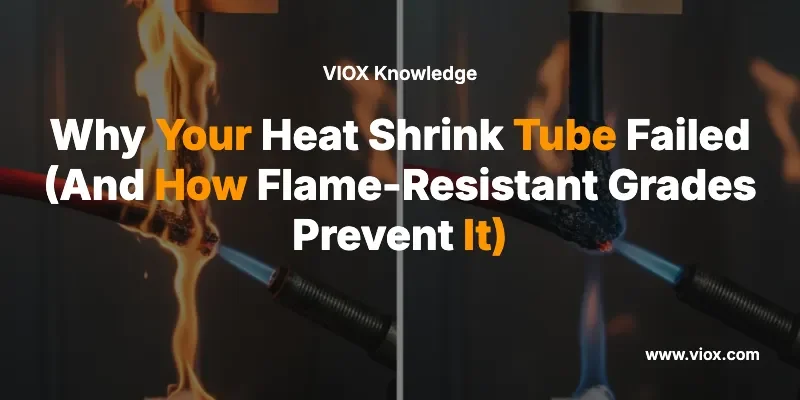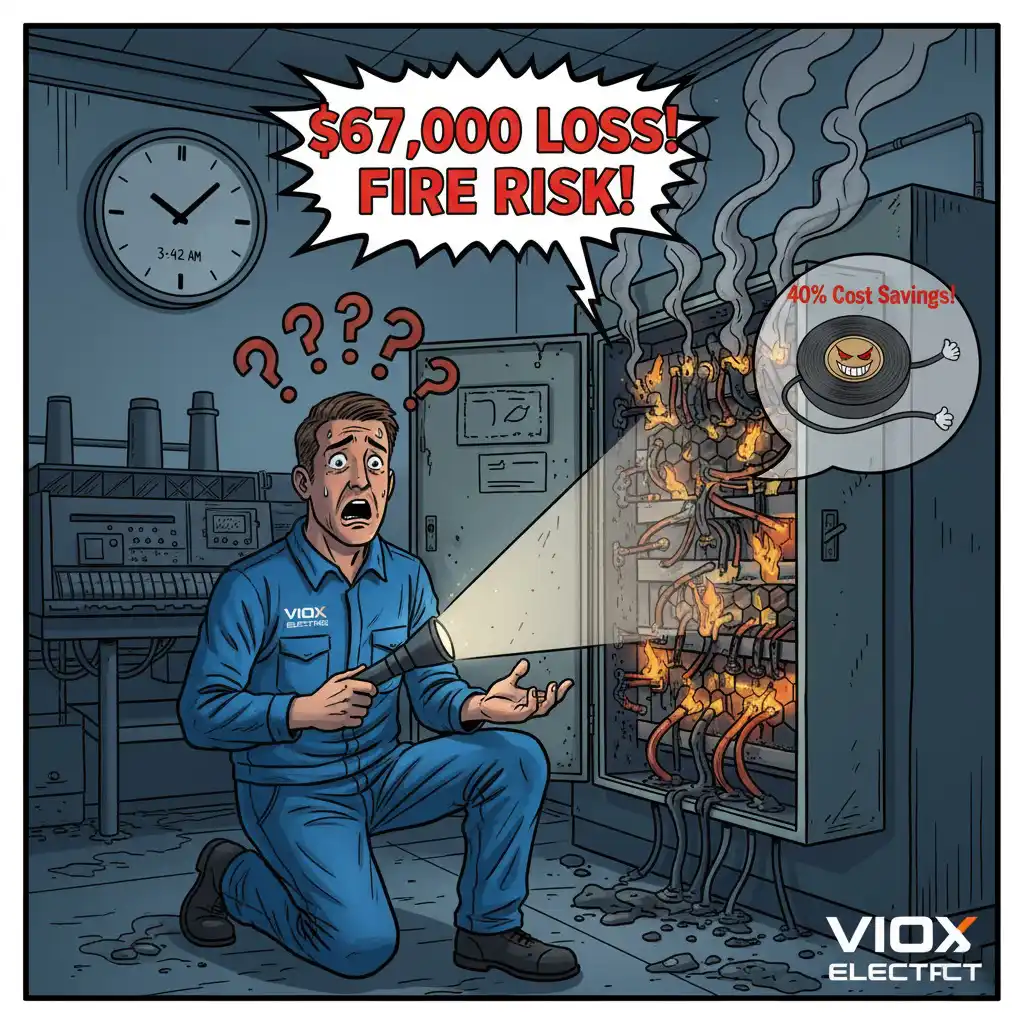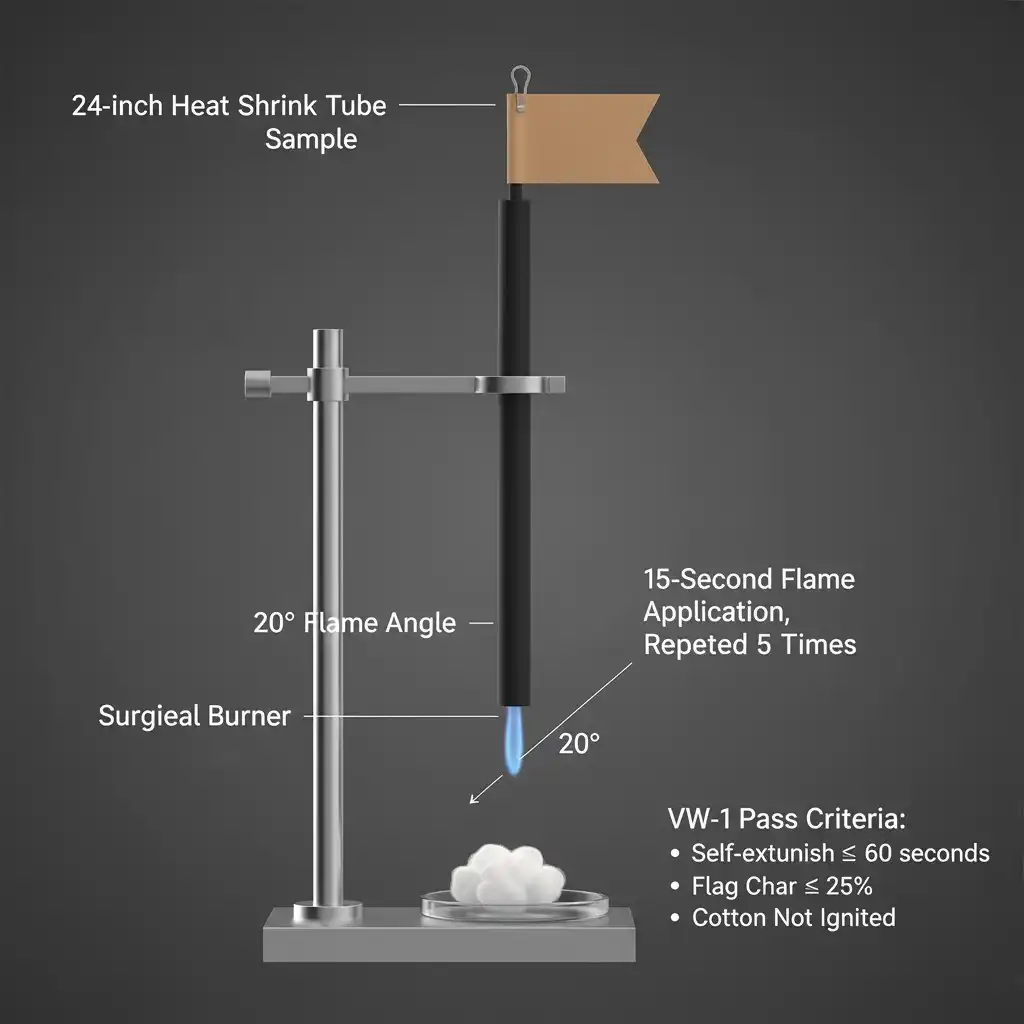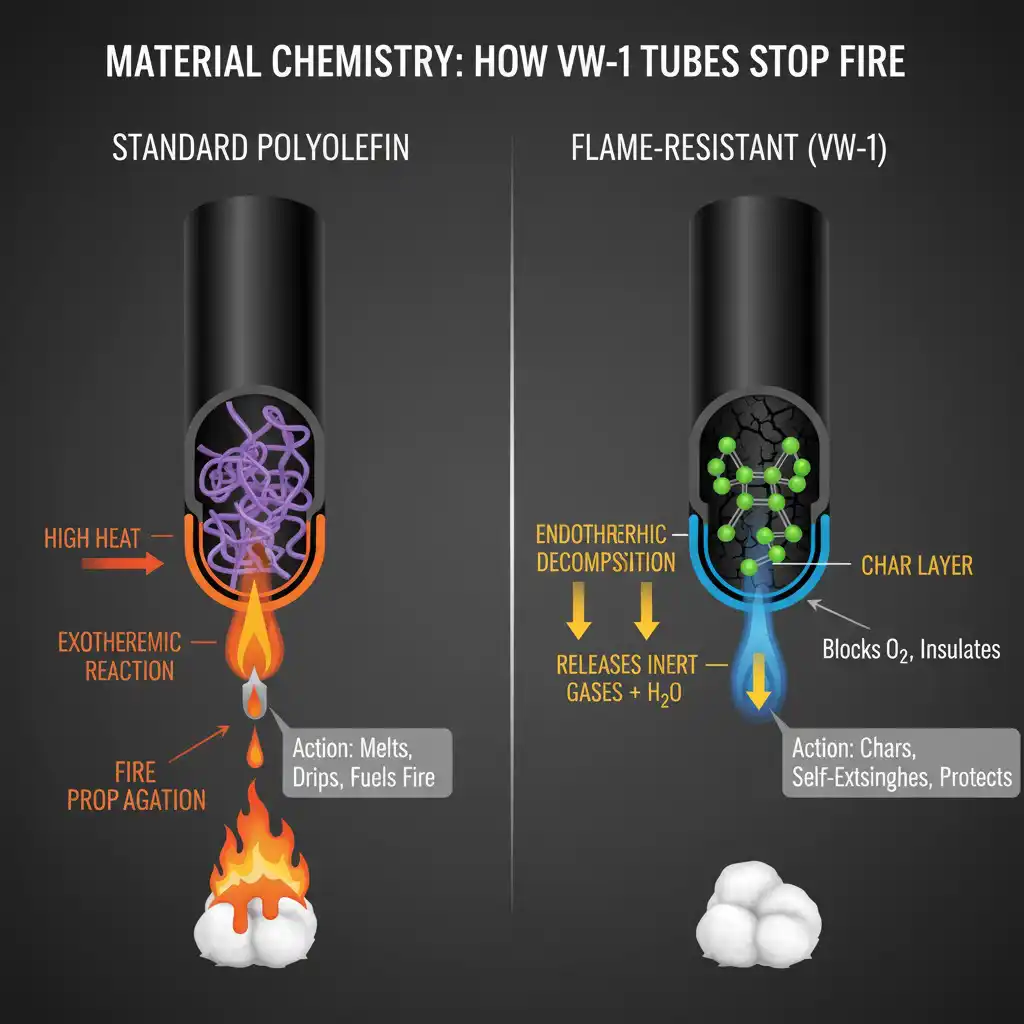3:42 AM. Your phone vibrates. “Main line down. Panel’s smoking.”
By the time you arrive at the plant, maintenance has killed power to Bay 3’s motor control panel. The acrid smell hits you before you even open the door. Inside, what should be neat rows of wiring connections now looks like a melted candle factory. The heat shrink tubes you carefully installed six months ago? They didn’t just fail—they helped the fire spread.
The panel inspector’s report lands on your desk two days later. Cause of failure: “Non-flame-retardant insulation material contributed to fire propagation.” Translation: you used standard heat shrink tubing where flame-resistant grades were required.
That 40% cost savings on “equivalent” tubing just became a $67,000 mistake. Welcome to the invisible difference between standard polyolefin heat shrink and UL 224 VW-1 flame-resistant grades—a distinction that seems trivial until it absolutely isn’t.
The Problem Nobody Talks About: Heat Shrink as Fire Fuel
Here’s what the datasheets don’t emphasize enough: standard heat shrink tubing is made from cross-linked polyolefin. Polyolefin is plastic. Plastic burns. Sometimes enthusiastically.
When an electrical fault dumps energy into a connection—think inrush current during a cold start, or harmonic heating from a VFD, or just a loose terminal creating resistance—the heat shrink tube becomes the weakest link. Standard tubes will melt. They’ll drip. And if the fault generates enough heat, they’ll ignite.
Once burning, standard polyolefin doesn’t just burn itself out. It keeps going. The molten drips can ignite cotton wire insulation below. The flame spreads along the tube’s length. You’ve essentially turned your wire management solution into a fuse of accelerant.
Flame-resistant heat shrink tubes do the opposite. When exposed to flame, they char and self-extinguish. The material chemistry is fundamentally different—not just “better,” but engineered with halogen-free flame retardant additives that react endothermically when heated, absorbing energy and forming a protective char layer. Think of it as the difference between gasoline and fire-retardant foam. Both are materials, but their behavior under fire stress is night and day.
The 60-Second Rule: What Makes Heat Shrink “Flame-Resistant”
The electrical industry needed a way to separate tubes that burn from tubes that don’t. Enter the VW-1 test—officially called the “Vertical Wire Flame Test” from UL 1581, and specified in the UL 224 standard for insulating tubing.
The test setup reads like a high school chemistry experiment. Mount a 24-inch sample of heat shrink tubing vertically. Place a Bunsen-style burner at a 20° angle below it. Put surgical cotton at the base (to catch flaming drips). Hang a kraft paper flag at the top (to measure flame spread).
Now the test begins:
- Apply flame for 15 seconds
- Remove flame
- Wait for the sample to self-extinguish (or up to 60 seconds)
- Repeat five times for a total of 75 seconds flame exposure
To pass VW-1 and earn “flame-resistant” status, the tube must:
- Self-extinguish within 60 seconds after each flame application—that’s the “60-Second Rule”
- Not burn more than 25% of the indicator flag
- Not ignite the surgical cotton with dripping material
Standard polyolefin heat shrink? Fails spectacularly. The tube melts, drips flaming material onto the cotton (which ignites), and the flame spreads upward past the 25% mark. Flame-resistant VW-1-rated tubes? The material chars, the flame self-extinguishes within 10-20 seconds, and nothing drips to ignite the cotton below.
The test is brutal by design. Five separate flame applications simulate repeated thermal stress—exactly what happens during multiple motor start cycles or intermittent fault conditions. If the tube can survive this gauntlet and still self-extinguish every single time, it earns the VW-1 rating marked on certified products.
Material Chemistry: Why Some Tubes Stop Burning and Others Don’t
Standard polyolefin heat shrink is cross-linked for strength and temperature stability. Cross-linking prevents the polymer chains from melting back into liquid, which is excellent for mechanical properties. Unfortunately, it does nothing to stop combustion.
Flame-resistant tubes add halogen-free flame retardant compounds—typically phosphorus-based or metal hydroxide additives that change the combustion chemistry:
When exposed to high heat:
- The additives decompose endothermically (absorbing heat energy from the environment)
- They release water vapor or inert gases that dilute combustible gases
- They form a carbonaceous char layer that insulates the underlying material
- The char layer prevents oxygen from reaching unburned material beneath
What you see: the tube surface blackens and hardens instead of melting. What’s happening chemically: the material is actively fighting the fire at a molecular level.
Temperature ratings remain similar between standard and flame-resistant grades—both typically operate from -55°C to 125°C for polyolefin formulations. The flame resistance additives don’t compromise electrical insulation properties or shrink ratios. A 2:1 or 3:1 shrink ratio flame-resistant tube performs identically to standard tubes under normal operating conditions. The difference only matters when things go wrong.
As of November 2025, the global flame-retardant heat shrink tubing market is valued at approximately $3.3 billion and projected to reach $4.32 billion by 2032, driven largely by increasingly stringent fire safety regulations in industrial, automotive, and aerospace applications.
When Flame Resistance Actually Matters (And When It Doesn’t)
Not every application requires VW-1-rated tubing. Using flame-resistant grades everywhere would be expensive overkill. But certain environments turn the lack of flame resistance from a minor spec detail into a genuine safety hazard.
You absolutely need flame-resistant heat shrink for:
Motor control panels and VFD applications: Variable frequency drives generate harmonic heating that can stress connections over time. Combine that with the high inrush currents during motor starting (typically 5-7x full-load amperage), and you have the perfect conditions for localized heating. If a connection fails, flame-resistant tubing prevents a small electrical fault from becoming a panel fire. UL 508A control panel standards increasingly reference flame-resistant wiring components for this reason.
High-voltage electric vehicle wiring: EV battery systems operate at 400V to 800V DC with fault currents that can exceed 1,000 amperes. During thermal runaway events or high-resistance connection failures, standard heat shrink can ignite and spread fire through the entire wire harness. EV manufacturers typically mandate VW-1 or higher ratings (some spec automotive-specific FMVSS 302 requirements) for all battery pack wiring.
Aerospace and military applications: MIL-DTL-23053 military specifications require flame-resistant heat shrink for aircraft wiring. At altitude, reduced air pressure changes combustion behavior, and cabin fires are existential threats. Flame-resistant tubes rated for aerospace use must pass even more stringent tests than standard VW-1.
Food processing and industrial environments with combustible dust: If your plant processes grain, sugar, plastics, or metal powders, any ignition source can trigger a dust explosion. Flame-resistant wiring components prevent electrical faults from becoming ignition sources. NFPA 79 industrial machinery standards recommend or require flame-resistant materials in these environments.
You can probably use standard heat shrink for:
Low-voltage signal wiring (under 50V) in office environments, non-critical instrumentation in climate-controlled buildings, prototyping and lab benches, residential repairs where building codes don’t specify flame ratings.
The decision framework:
Ask three questions:
- What’s the fault current available at this connection?
- What’s nearby that could catch fire if this connection fails?
- Does the governing standard (UL 508A, NEC, IEC 60204) specify flame-resistant materials?
If fault current exceeds 10 amperes, or if combustible materials are within 3 feet, or if codes require it—spec flame-resistant tubes.
How to Verify You’re Actually Getting VW-1 Rated Tubing
Here’s an uncomfortable truth: not all “flame-resistant” heat shrink tubes actually are. The counterfeit and substandard tubing market is real, particularly for products imported without proper UL certification.
Look for these markings on the tubing itself:
- “VW-1” or “VW-1 Flame Retardant” printed on the tube
- UL file number (starts with “E” followed by 6 digits, e.g., E228117)
- “UL 224” or “CSA C22.2 No. 198.1” standard reference
- Temperature rating (typically “125°C” for polyolefin)
- Nhận dạng nhà sản xuất
Red flags that indicate potentially non-compliant tubing:
- No markings whatsoever on the tube surface
- Markings that wash off easily (genuine markings are ink-printed and permanent)
- Packaging claims VW-1 rating but tubes aren’t marked
- Price is suspiciously low compared to certified suppliers
- Vendor can’t provide UL file number or test reports
For critical applications, request documentation:
- UL certification letter showing the specific product line
- Test reports confirming VW-1 compliance
- Material safety data sheet (MSDS) showing flame retardant additives
- RoHS compliance certificate (halogen-free flame retardants should be RoHS-compliant)
The price difference between standard and VW-1 flame-resistant polyolefin heat shrink is typically 30-50%, depending on size and quantity. Given that a single panel fire can cost $50,000+ in equipment replacement, production downtime, and remediation, the ROI calculation is straightforward. Spend the extra dollar per meter. Sleep better at night.
Selection Guide: Matching Flame-Resistant Grades to Your Application
Not all flame-resistant tubes are created equal. Beyond basic VW-1 compliance, consider these specifications:
Shrink ratio:
- 2:1 (most common): Fits wire diameters from 2mm to 4mm when you use 4mm tubing
- 3:1 (more versatile): Covers wider size ranges, useful for irregular shapes
- 4:1 (specialty): High-ratio tubes for covering large connectors or splices with minimal inventory
Wall thickness:
- Thin wall (0.3-0.5mm): Tight spaces, minimal weight, still passes VW-1
- Medium wall (0.5-1.0mm): Standard industrial applications, better abrasion resistance
- Heavy wall (1.0mm+): High mechanical stress, outdoor exposure, underground installations
Special features:
- Dual-wall with adhesive: Creates moisture seal when heated (critical for outdoor or marine)
- Halogen-free certification: Required in Europe (RoHS), preferred in enclosed spaces
- UV-resistant formulations: For outdoor installations with direct sun exposure
- High-temperature variants: Up to 150°C or 175°C for applications near motors or transformers
For typical motor control panel applications, specify:
- 2:1 or 3:1 shrink ratio
- Thin or medium wall
- UL 224 VW-1 rated
- Halogen-free if possible
- Temperature rating: -55°C to 125°C minimum
- Voltage rating: 600V (standard for most control circuits)
Pro mẹo: Buy from distributors who can provide cut-to-length services with VW-1 certification maintained. Pre-cut tubes reduce installation time and ensure you’re using certified material throughout your inventory rather than mixing certified and non-certified stock.
The Real Cost of Using Standard Tubes Where You Shouldn’t
Let’s run the numbers on that 3 AM panel fire from the opening:
Chi phí trực tiếp:
- Panel replacement and wiring: $18,000
- Emergency electrician call-out: $2,400
- Inspection and certification: $3,200
- Subtotal: $23,600
Chi phí gián tiếp:
- Production line downtime (14 hours at $3,200/hour): $44,800
- Expedited shipping for replacement components: $1,800
- Insurance deductible: $5,000
- Subtotal: $51,600
Total incident cost: $75,400
Cost to have used VW-1 flame-resistant tubes initially:
- 50 meters of flame-resistant heat shrink instead of standard: $145 additional cost
That’s a cost multiplier of 520:1. The fire wasn’t even that bad—no injuries, no surrounding equipment damage, containment within one panel. A more severe incident could easily exceed $250,000 when you factor in lost contracts, regulatory fines, and reputation damage.
The engineering decision isn’t really about whether flame-resistant tubes cost more. It’s about whether you’re willing to bet $75,000 that your connections will never fault under thermal stress. Most panels will be fine. But in a facility with 200 panels running 24/7 for 10 years? The question becomes which panel will be the statistically unlucky one.
What to Do Right Now
If you’re speccing a new installation:
- Review the applicable standards (UL 508A for control panels, NEC Articles 300-400 for wiring methods)
- Identify any areas where fault currents exceed 10A or combustible materials are present
- Specify “UL 224 VW-1 flame-resistant heat shrink tubing” in your bill of materials
- Require certification documentation from your supplier
- Verify tubing markings during receiving inspection
If you have existing installations with standard tubing:
- Conduct a risk assessment: what’s the fault current? What’s nearby?
- Prioritize replacement in high-risk areas first (motor feeders, VFD connections, high-voltage)
- Schedule replacements during planned downtime rather than waiting for a failure
- Document the upgrade for insurance and compliance purposes
If you’re unsure what you currently have:
- Check the tube markings under good lighting with reading glasses if needed
- Contact your original installer or supplier for product documentation
- If markings are illegible or absent, assume standard non-flame-resistant and plan replacement
The tubes you installed were probably “good enough” when everything works perfectly. But electrical systems don’t always work perfectly. Insulation ages. Connections loosen. Surges happen. When something goes wrong at 3 AM, you want insulation that fights the fire instead of feeding it.
Why VIOX ELECTRIC Flame-Resistant Heat Shrink Tubes
VIOX ELECTRIC manufactures UL 224 VW-1 certified flame-resistant heat shrink tubing specifically engineered for industrial motor control and power distribution applications. Our tubes meet or exceed:
- UL 224 / CSA C22.2 No. 198.1 standards
- VW-1 vertical flame test requirements
- RoHS compliance for halogen-free flame retardant formulations
- Temperature range: -55°C to 125°C
- Voltage ratings: 600V
- Shrink ratios: 2:1, 3:1, and 4:1 available
Every batch includes certification documentation and permanent tube markings for traceability. Available in cut-to-length services for panel builders and OEMs.
Contact VIOX Technical Support for application-specific recommendations and volume pricing.





